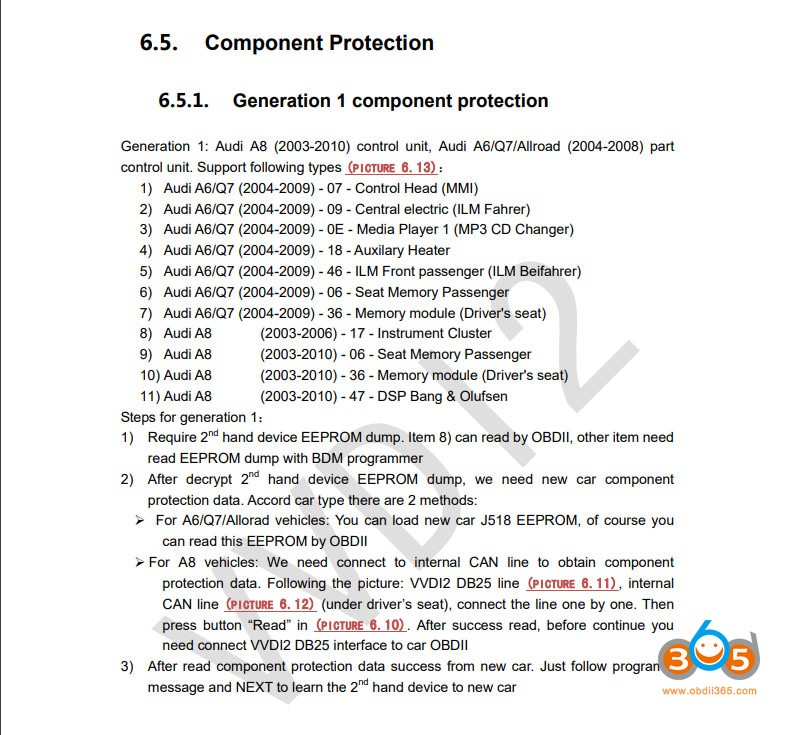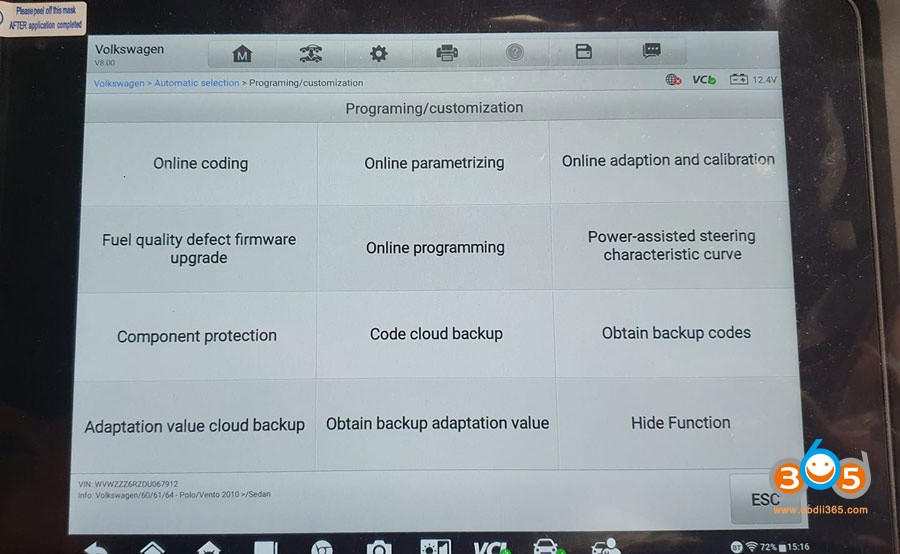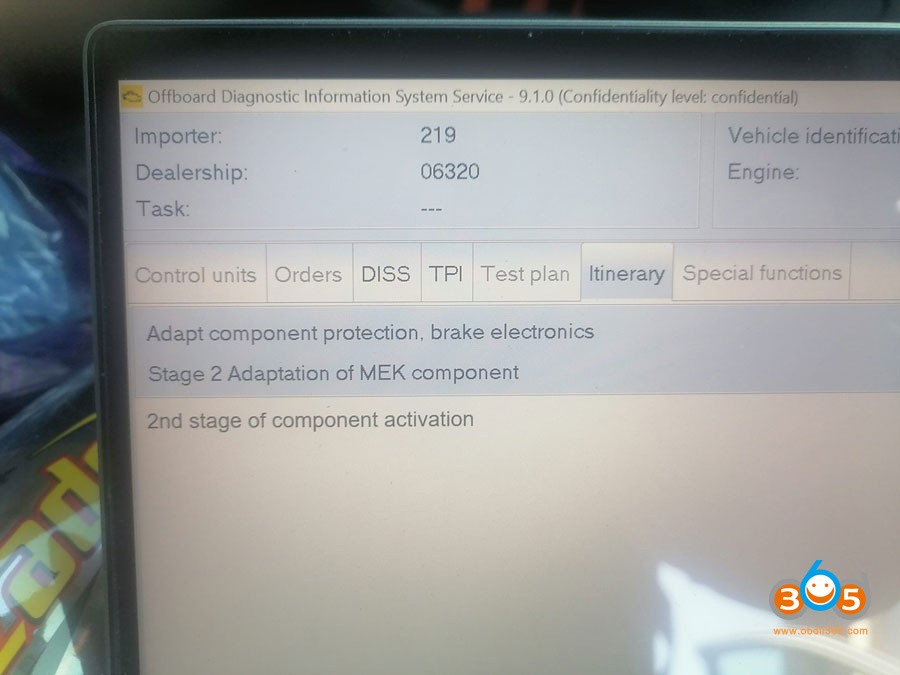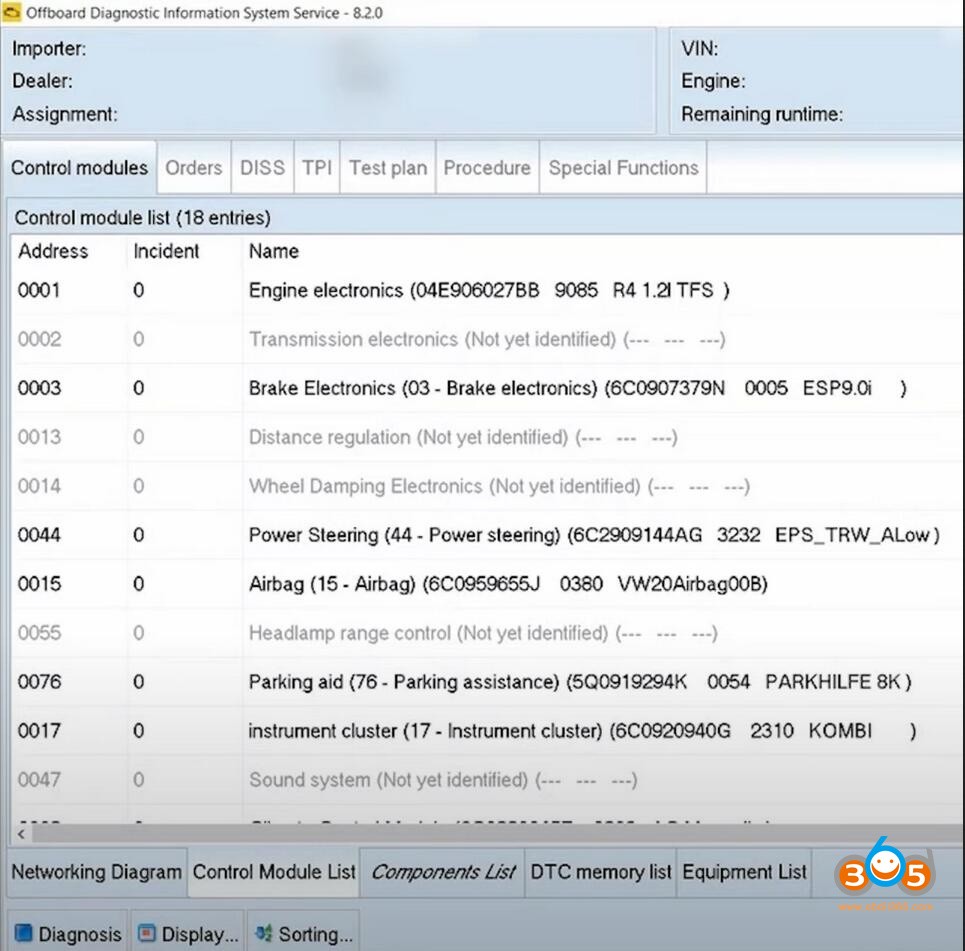Vw Remove Component Protection Vcds is a complex process, but with the right tools and expertise, CAR-CODING.EDU.VN can help you navigate it safely and efficiently through remote automotive coding support. We offer expert assistance to remove component protection, ensuring your VW, Audi, or other VAG vehicle functions optimally. Whether you’re a seasoned technician or a DIY enthusiast, our coding, ECU programming, and hidden features activation services are tailored to meet your needs.
Contents
- 1. What is Component Protection in VW Vehicles?
- 2. What are the Generations of Component Protection?
- 3. Which Tools Can Remove VW Component Protection?
- 3.1 ODIS Online
- 3.2 Xhorse VVDI2
- 3.3 Autel Scanners
- 3.4 AVDI Abrites
- 3.5 FVDI/SVCI
- 3.6 Tools That Cannot Remove Component Protection
- 4. How to Remove Component Protection with ODIS Online
- 5. The Role of VCDS in VW/Audi Diagnostics and Coding
- 6. Why Remote Automotive Coding Support is Essential
- 7. How CAR-CODING.EDU.VN Can Help
- 8. Potential Risks of Incorrect Coding
- 9. Understanding VCDS Coding for VW/Audi Vehicles
- 10. Activating Hidden Features with VCDS
- 11. The Importance of Proper Diagnostic Procedures
- 12. Common Coding Errors and How to Avoid Them
- 13. Best Practices for Using VCDS
- 14. How to Connect with CAR-CODING.EDU.VN for Remote Support
- 15. Remote Automotive Coding Support: A Step-by-Step Guide
- 16. Choosing the Right Diagnostic Tool for Your Needs
- 17. Understanding ECU Programming and Flashing
- 18. The Benefits of ECU Remapping
- 19. Navigating Complex Coding Issues: When to Seek Help
- 20. How to Stay Updated on the Latest Coding Techniques
- 21. What are the Common VCDS Coding Error Codes?
- 22. Understanding Security Access Codes in VCDS
- 23. What is the Long Coding Helper in VCDS?
- 24. How to Backup and Restore Control Module Coding with VCDS
- 25. Is it Possible to Activate Audi Drive Select Retrofit with VCDS?
- 26. Is There a Way to Disable the Seat Belt Warning Chime Using VCDS?
- 27. What is the Process for Calibrating Air Suspension with VCDS?
- 28. Can I Perform a Throttle Body Alignment Using VCDS?
- 29. What are the Steps to Reset the Service Reminder Indicator with VCDS?
- 30. How Can CAR-CODING.EDU.VN Help with Component Protection Removal?
- 31. What are the Benefits of Using CAR-CODING.EDU.VN’s Services?
- 32. Frequently Asked Questions (FAQ) About VW Component Protection and VCDS Coding
1. What is Component Protection in VW Vehicles?
Component Protection (CP) is a security measure implemented by Volkswagen (VW) and other brands within the Volkswagen Audi Group (VAG) to deter theft and prevent the unauthorized swapping of vehicle components. When a new or used control module with CP is installed in a vehicle, it won’t function fully until it’s “matched” or adapted to the car’s unique identification through an online process with VAG’s central server.
- The system was initially introduced in high-end Audi models in the mid-2000s, such as the A8 (D3/4E) and A6 (C6/4F), before gradually extending to other models across the VAG portfolio.
- While its primary goal is to discourage the transplanting of stolen modules or parts from stolen vehicles, it’s also viewed by some as a means to protect dealer service revenue.
2. What are the Generations of Component Protection?
There are typically three generations of component protection in VAG vehicles:
- Generation 1: Found in models like Audi A8 (2003+), A6/A6 Allroad, and Q7 (2004+).
- Generation 2: Common in vehicles manufactured between 2008 and 2015.
- Generation 3: Installed in vehicles produced from 2016 onwards.
3. Which Tools Can Remove VW Component Protection?
Several tools claim to remove VW Component Protection, but their effectiveness and safety vary significantly. Here’s an overview:
3.1 ODIS Online
- Effectiveness: ODIS (Offboard Diagnostic Information System) Online is the only tool officially sanctioned by VAG for correctly removing Component Protection and enabling full functionality on new control units.
- Risk: Using other tools can irreparably damage new components while attempting to remove CP.
- Requirement: ODIS Online requires a VAS5054a, VXDIAG VCX SE 6154, CarDAQ-M, or other J2534 adapters, along with an active online GeKo account.
- Limitation: ODIS Offline cannot remove CP; an online connection is mandatory.
3.2 Xhorse VVDI2
- Effectiveness: VVDI2 is capable of removing component protection for older VW Audi cars (typically up to 2008/2009). It’s less effective on newer VAG vehicles.
- Functionality: This tool allows adapting used parts to other cars, generally requiring a two-step process: (1) Resetting the module to a virgin state, and (2) Adapting the module to the target vehicle.
- Compatibility:
- Generation 1: Audi A8 (2003-2010) modules, Audi A6/Q7/Allroad (2004-2008) part modules.
- Generation 2: Some A6/Q7/Allroad and A4/A5/Q5 modules.
- Procedure: Often involves reading EEPROM dumps from both the gateway module of the donor vehicle and the vehicle receiving the module.
 Xhorse VVDI2 Component Protection
Xhorse VVDI2 Component Protection
3.3 Autel Scanners
- Past Capabilities: Autel IM608 previously offered component protection removal.
- Current Status: This function has been removed from Autel IM608. The Auro IM600 may still offer this functionality.
- Regional Variations: Autel Ultra units purchased from the IMEA region can perform VAG online programming and component protection functions.
- Limitation: Online Autel products generally cannot remove CP.
 Autel Ultra Online Programming
Autel Ultra Online Programming
3.4 AVDI Abrites
- Licensing: Component protection capabilities are largely concentrated in the VN002 Special Function License. AVDI also offers VN017 for newer models with online capability.
- VN002 Features:
- Component Protection Generation 1 (Audi A8 2003-2010: MMI, CD-Changer, ILM, DSP, seats, etc.; Audi A6/Q7 2004-2008: MP3 player, CD changer; Audi A5/Q5 2007-2012: MMI 2G modules). The immobilizer is the master in this procedure.
- Component Protection Generation 2 (requires dump from the gateway of the donor vehicle): Audi A6/A7/A8/Q7 2004-2010: EZS-Kessy, Comfort module, Climantronic, Airbag, Instrument cluster, infotainment; Audi A4/A5/Q5 2007-2015: similar modules; Audi A6/A7/A8/ and VW Touareg 2010+: Dashboard, Infotainment, and Climatronic modules by OBDII. The gateway is the master here.
- VN017 Features: Designed for vehicles produced between 2010 and 2017. It allows replacing ALL component protection-related modules (most via OBDII), requiring both donor and host gateways. This license enables reading and updating component protection bytes of the Lear Gateway, and replacing dashboards, infotainment, CEM, and Climatronic modules.
- Supported Models (with Lear Gateway): Audi A6/A7/A8 (2010-2017), VW Touareg (2010-2017).
3.5 FVDI/SVCI
- Capabilities: FVDI (various versions) can remove component protection, often requiring EEPROM dumps from the donor car’s gateway and the target vehicle.
- Review Notes: Users have reported success with comfort panel and dash adaptations, but caution against reading dumps via FVDI to avoid module lock-up.
- Limitations: FVDI is discontinued, and SVCI is likely to follow suit.
3.6 Tools That Cannot Remove Component Protection
- Vag Can Pro
- VCDS (VAG-COM Diagnostic System)
- Launch X431 (all scanners)
 ODIS Remove Component Protection
ODIS Remove Component Protection
4. How to Remove Component Protection with ODIS Online
Here’s a general outline of the process for removing Component Protection using ODIS Online:
- Enter vehicle details into ODIS.
- Run a full diagnostic scan.
- Identify the control module with Component Protection.
- Access the “Guided Functions” for that module.
- Run the guided function and allow the tool to complete the programming sequence.
- Verify that the Component Protection has been successfully removed.
 ODIS Online Remove Component Protection
ODIS Online Remove Component Protection
5. The Role of VCDS in VW/Audi Diagnostics and Coding
While VCDS (VAG-COM Diagnostic System) cannot directly remove Component Protection, it remains a valuable tool for diagnosing and coding various aspects of VW, Audi, Skoda, and SEAT vehicles. VCDS allows technicians to:
- Read and clear diagnostic trouble codes (DTCs)
- View live data from sensors and control modules
- Perform basic settings and adaptations
- Access and modify control module settings through coding
- Activate certain hidden features or customize vehicle behavior
6. Why Remote Automotive Coding Support is Essential
Modern vehicle coding, especially when dealing with Component Protection or advanced ECU programming, is complex and carries significant risk. Remote automotive coding support offers several key advantages:
- Expert Guidance: Access to experienced professionals who understand the intricacies of VAG vehicle systems.
- Reduced Risk: Minimizes the potential for errors that can lead to ECU damage or malfunction.
- Time Savings: Experts can quickly diagnose and resolve coding issues, saving valuable time.
- Cost-Effectiveness: Often more affordable than dealership services, especially for specialized tasks.
- Up-to-Date Knowledge: Professionals stay current with the latest coding procedures and software updates.
7. How CAR-CODING.EDU.VN Can Help
CAR-CODING.EDU.VN provides remote automotive coding support for VW, Audi, and other VAG vehicles. Our services include:
- Component Protection Removal: Expert assistance in removing CP using ODIS Online and other appropriate tools.
- ECU Programming and Flashing: Safe and reliable ECU remapping, software updates, and performance tuning.
- Hidden Feature Activation: Unlock hidden features and customize your vehicle to your preferences.
- Diagnostic Assistance: Remote troubleshooting of complex vehicle issues.
- Coding and Adaptation: Precise coding and adaptation of control modules.
8. Potential Risks of Incorrect Coding
Incorrect coding can lead to a range of problems, including:
- ECU damage, requiring costly replacement
- Malfunctioning vehicle systems (e.g., ABS, airbags, engine control)
- Warning lights and error codes
- Reduced vehicle performance
- Voided warranties
9. Understanding VCDS Coding for VW/Audi Vehicles
VCDS coding involves modifying specific values within a control module to alter its behavior or enable/disable certain features. This is done by accessing the control module through VCDS software and changing the coding string. Understanding the coding logic and having accurate coding information is crucial to avoid errors.
Example: Activating Coming Home/Leaving Home Lights
- Select Control Module 09 (Central Electronics).
- Click on “Coding – 07”.
- Use the Long Coding Helper to navigate to the appropriate byte and bit.
- Check the box to enable the function.
- Click “Do It!” to save the changes.
10. Activating Hidden Features with VCDS
VCDS can unlock numerous hidden features in VW/Audi vehicles, enhancing convenience and personalization. Some popular examples include:
- Gauge Needle Sweep: Briefly sweeps the instrument cluster needles upon startup.
- Cornering Lights: Activates fog lights when turning at low speeds.
- Emergency Brake Flashing: Automatically flashes brake lights rapidly during hard braking.
- Comfort Windows Operation: Allows opening/closing windows using the remote key fob.
- DRL Dimming with Turn Signals: Dims the daytime running lights on the side where the turn signal is activated.
11. The Importance of Proper Diagnostic Procedures
Before attempting any coding or programming, a thorough diagnostic scan is essential. This helps identify any existing issues that could interfere with the coding process or be exacerbated by it. Addressing underlying problems before coding is crucial for ensuring successful and safe modifications.
12. Common Coding Errors and How to Avoid Them
- Incorrect Coding Values: Always double-check coding values against reliable sources (e.g., Ross-Tech Wiki, online forums)
- Software Compatibility Issues: Ensure that the VCDS software and interface are compatible with the vehicle’s model year and control modules.
- Interrupted Coding Process: Avoid interrupting the coding process (e.g., by disconnecting the interface or turning off the ignition) as this can corrupt the ECU.
- Battery Voltage Problems: Maintain a stable battery voltage during coding by using a battery charger or maintainer.
13. Best Practices for Using VCDS
- Always back up the original coding before making any changes.
- Use the Long Coding Helper feature in VCDS to avoid manual coding errors.
- Follow coding instructions carefully and double-check each step.
- Test the modified feature or system after coding to ensure it functions correctly.
- If unsure about a coding procedure, seek expert assistance from a qualified technician or online forum.
14. How to Connect with CAR-CODING.EDU.VN for Remote Support
Getting remote coding support from CAR-CODING.EDU.VN is easy:
- Contact us via WhatsApp: +1 (641) 206-8880
- Visit our website: CAR-CODING.EDU.VN
- Describe your vehicle (make, model, year) and the coding task you need assistance with.
- Our team will assess your requirements and provide a quote.
- Schedule a remote support session at your convenience.
- Connect your VCDS interface to your vehicle and your computer.
- Grant our technician remote access to your computer.
- Our technician will perform the necessary coding or programming tasks under your supervision.
15. Remote Automotive Coding Support: A Step-by-Step Guide
Here’s a detailed look at how remote automotive coding support works:
| Step | Description |
|---|---|
| 1 | Contact CAR-CODING.EDU.VN and describe your coding needs. |
| 2 | Receive a quote and schedule a remote support session. |
| 3 | Connect your diagnostic interface (e.g., VCDS) to your vehicle and computer. |
| 4 | Download and install remote access software (e.g., TeamViewer). |
| 5 | Provide our technician with remote access credentials. |
| 6 | Our technician remotely performs the coding or programming tasks. |
| 7 | You observe and verify the changes made. |
| 8 | Test the modified feature or system to ensure it functions correctly. |
16. Choosing the Right Diagnostic Tool for Your Needs
Selecting the appropriate diagnostic tool is crucial for effective VW/Audi coding and diagnostics. Consider the following factors:
- Compatibility: Ensure the tool supports your vehicle’s make, model, and year.
- Functionality: Choose a tool that offers the features you need (e.g., DTC reading/clearing, live data, coding, adaptation, Component Protection removal).
- Ease of Use: Opt for a tool with a user-friendly interface and clear instructions.
- Support and Updates: Select a tool from a reputable manufacturer that provides regular software updates and technical support.
- Budget: Balance your needs and desired features with your budget constraints.
17. Understanding ECU Programming and Flashing
ECU programming, also known as flashing, involves replacing the existing software in a vehicle’s Engine Control Unit (ECU) or other control modules with a modified or updated version. This can be done to:
- Improve engine performance (e.g., increase horsepower and torque)
- Enhance fuel efficiency
- Fix software bugs or glitches
- Update the ECU with the latest software version
- Adapt the ECU to different hardware configurations
Warning: ECU programming carries inherent risks and should only be performed by qualified professionals. Incorrect programming can damage the ECU and lead to serious vehicle problems.
18. The Benefits of ECU Remapping
ECU remapping, also called chip tuning, involves modifying the software in the ECU to optimize engine performance. Benefits of ECU remapping include:
- Increased horsepower and torque
- Improved throttle response
- Enhanced fuel efficiency
- Smoother engine operation
- Removal of speed limiters
- Optimization for aftermarket modifications (e.g., exhaust systems, air intakes)
19. Navigating Complex Coding Issues: When to Seek Help
While VCDS is a powerful tool, some coding issues can be complex and require specialized knowledge. Seek expert assistance if you encounter:
- Component Protection problems
- ECU programming or flashing procedures
- Coding errors that you cannot resolve
- Unfamiliar or poorly documented coding parameters
- Any situation where you are unsure about the coding process
20. How to Stay Updated on the Latest Coding Techniques
- Follow reputable online forums and communities dedicated to VW/Audi coding.
- Subscribe to newsletters and blogs from trusted sources.
- Attend training courses and workshops on VCDS coding and ECU programming.
- Stay informed about software updates and new features in VCDS and other diagnostic tools.
- Network with other technicians and coding enthusiasts to share knowledge and experiences.
21. What are the Common VCDS Coding Error Codes?
Common VCDS coding error codes often point to communication problems, incorrect security access, or invalid coding values. Consulting the Ross-Tech Wiki or other online resources for specific error code descriptions and troubleshooting steps is crucial.
- Error 31: Out of Range – Indicates that the entered value is outside the acceptable range for that coding parameter.
- Error 22: Conditions Not Correct or Request Sequence Error – Suggests that certain prerequisites for the coding process have not been met.
- Error 11: Incorrect Adaptation Length – Occurs when the adaptation value is not the correct length (e.g., trying to write a single byte value into a two-byte field).
22. Understanding Security Access Codes in VCDS
Many advanced coding and adaptation functions in VCDS require a security access code to unlock the control module. These codes prevent unauthorized access to sensitive settings and protect the vehicle’s systems. Security access codes can be found in the Ross-Tech Wiki or other online resources.
23. What is the Long Coding Helper in VCDS?
The Long Coding Helper is a feature in VCDS that simplifies the coding process by providing a graphical interface for selecting and deselecting individual bits within a coding string. This eliminates the need to manually calculate and enter coding values, reducing the risk of errors.
24. How to Backup and Restore Control Module Coding with VCDS
Before making any coding changes, it’s essential to back up the original coding of the control module. This allows you to easily restore the original settings if something goes wrong.
Backup:
- Connect VCDS to the vehicle and select the control module.
- Click on “Coding – 07”.
- Copy the existing coding string and save it to a text file.
Restore:
- Connect VCDS to the vehicle and select the control module.
- Click on “Coding – 07”.
- Enter the backed-up coding string into the coding field.
- Click “Do It!” to save the changes.
25. Is it Possible to Activate Audi Drive Select Retrofit with VCDS?
Yes, Audi Drive Select retrofit can often be activated with VCDS, but it requires specific coding changes in multiple control modules. The exact procedure varies depending on the vehicle model and year. Consulting a specialized guide or seeking expert assistance is highly recommended.
26. Is There a Way to Disable the Seat Belt Warning Chime Using VCDS?
Yes, the seat belt warning chime can be disabled using VCDS, but this should be done with caution and only if you fully understand the implications. Disabling safety features can increase the risk of injury in an accident.
27. What is the Process for Calibrating Air Suspension with VCDS?
Calibrating air suspension with VCDS involves measuring the ride height at each corner of the vehicle and entering the values into the control module. This ensures that the air suspension system maintains the correct ride height and leveling. The procedure requires precise measurements and careful attention to detail.
28. Can I Perform a Throttle Body Alignment Using VCDS?
Yes, a throttle body alignment (TBA) can be performed using VCDS to reset the throttle valve position sensor and ensure smooth engine idling. The procedure is typically performed after cleaning the throttle body or replacing the ECU.
29. What are the Steps to Reset the Service Reminder Indicator with VCDS?
The service reminder indicator can be reset using VCDS by accessing the Instrument Cluster control module and performing a service reset function. The exact steps may vary depending on the vehicle model and year.
30. How Can CAR-CODING.EDU.VN Help with Component Protection Removal?
CAR-CODING.EDU.VN offers professional remote support for Component Protection removal on VW, Audi, Skoda, and SEAT vehicles. Our experienced technicians can guide you through the process using ODIS Online and other appropriate tools, ensuring a safe and successful outcome.
- Expertise: Our technicians have extensive knowledge of VAG vehicle systems and coding procedures.
- Safety: We prioritize safety and take precautions to minimize the risk of errors.
- Efficiency: We can quickly diagnose and resolve coding issues, saving you time and money.
- Convenience: Our remote support services allow you to get the help you need from the comfort of your own garage.
31. What are the Benefits of Using CAR-CODING.EDU.VN’s Services?
- Save Time and Money: Avoid costly trips to the dealership.
- Get Expert Help: Access experienced technicians who can solve complex coding problems.
- Minimize Risk: Reduce the potential for errors that can damage your vehicle’s systems.
- Enhance Your Vehicle: Unlock hidden features and customize your vehicle to your preferences.
- Stay Up-to-Date: Keep your vehicle’s software and coding up-to-date with the latest updates.
32. Frequently Asked Questions (FAQ) About VW Component Protection and VCDS Coding
Q1: Is it safe to remove Component Protection myself?
Removing Component Protection yourself can be risky if you lack the necessary expertise and equipment. Using the wrong tools or procedures can damage your vehicle’s control modules.
Q2: Can CAR-CODING.EDU.VN remotely remove Component Protection on my VW/Audi?
Yes, we offer remote support for Component Protection removal using ODIS Online and other appropriate tools.
Q3: What equipment do I need for remote Component Protection removal?
You will typically need a VCDS interface, a laptop computer, a stable internet connection, and potentially a VAS5054a, VXDIAG VCX SE 6154, or CarDAQ-M adapter.
Q4: How much does remote Component Protection removal cost?
The cost varies depending on the vehicle model, year, and complexity of the task. Contact us for a personalized quote.
Q5: What types of vehicles and features do you support?
We support a wide range of VW, Audi, Skoda, and SEAT vehicles and can assist with various coding tasks, including Component Protection removal, ECU programming, hidden feature activation, and more.
Q6: How long does a remote Component Protection removal session typically take?
The duration varies depending on the vehicle and the specific situation, but it typically takes between 30 minutes and 2 hours.
Q7: What happens if something goes wrong during the remote session?
Our technicians take precautions to minimize the risk of errors, and we always back up the original coding before making any changes. If a problem occurs, we will work with you to resolve it.
Q8: Do I need any special software or licenses to use your remote support services?
You will need a VCDS interface and software, but you do not need any special licenses to use our remote support services.
Q9: How do I schedule a remote support session?
Contact us via WhatsApp (+1 (641) 206-8880) or visit our website (CAR-CODING.EDU.VN) to schedule a session.
Q10: What if I’m not satisfied with the remote support service?
We are committed to providing excellent customer service. If you are not satisfied with our service, please contact us, and we will do our best to resolve the issue.
Component Protection removal and advanced VW/Audi coding require expertise and caution. CAR-CODING.EDU.VN provides professional remote support to ensure safe and successful outcomes. Contact us today for assistance! Our office is located at 100 Tech Innovation Dr, Suite 500, San Jose, CA 95110, United States. Call or text us on Whatsapp: +1 (641) 206-8880.